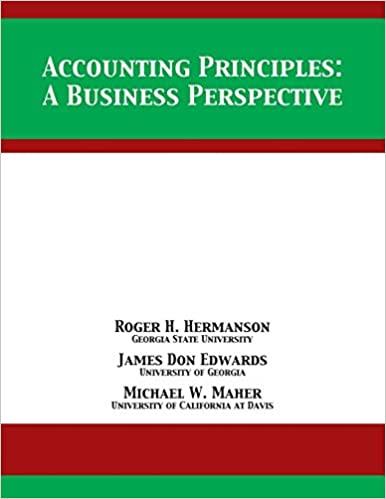Question
a. AM Express Inc. is considering the purchase of an additional delivery vehicle for $55,000 on January 1, 20Y1. The truck is expected to have
a. AM Express Inc. is considering the purchase of an additional delivery vehicle for $55,000 on January 1, 20Y1. The truck is expected to have a five-year life with an expected residual value of $15,000 at the end of five years. The expected additional revenues from the added delivery capacity are anticipated to be $58,000 per year for each of the next five years. A driver will cost $42,000 in 20Y1, with an expected annual salary increase of $1,000 for each year thereafter. The annual operating costs for the truck are estimated to be $3,000 per year.
| Present Value of $1 at Compound Interest | |||||
| Year | 6% | 10% | 12% | 15% | 20% |
| 1 | 0.943 | 0.909 | 0.893 | 0.870 | 0.833 |
| 2 | 0.890 | 0.826 | 0.797 | 0.756 | 0.694 |
| 3 | 0.840 | 0.751 | 0.712 | 0.658 | 0.579 |
| 4 | 0.792 | 0.683 | 0.636 | 0.572 | 0.482 |
| 5 | 0.747 | 0.621 | 0.567 | 0.497 | 0.402 |
| 6 | 0.705 | 0.564 | 0.507 | 0.432 | 0.335 |
| 7 | 0.665 | 0.513 | 0.452 | 0.376 | 0.279 |
| 8 | 0.627 | 0.467 | 0.404 | 0.327 | 0.233 |
| 9 | 0.592 | 0.424 | 0.361 | 0.284 | 0.194 |
| 10 | 0.558 | 0.386 | 0.322 | 0.247 | 0.162 |
Determine the expected annual net cash flows from the delivery truck investment for 20Y120Y5.
| Annual Net Cash Flow | |
| 20Y1 | $fill in the blank 1 |
| 20Y2 | $fill in the blank 2 |
| 20Y3 | $fill in the blank 3 |
| 20Y4 | $fill in the blank 4 |
| 20Y5 | $fill in the blank 5 |
Calculate the net present value of the investment, assuming that the minimum desired rate of return is 12%. (If required, round to the nearest dollar.) Use the table of the present value of $1 presented above. If required, use the minus sign to indicate a negative net present value.
| Present value of annual net cash flows | $fill in the blank 6 |
| Investment | $fill in the blank 7 |
| Net present value |
b.
Buckeye Healthcare Corp. is proposing to spend $71,896 on a six-year project that has estimated net cash flows of $19,000 for each of the six years.
| Present Value of an Annuity of $1 at Compound Interest | |||||
| Year | 6% | 10% | 12% | 15% | 20% |
| 1 | 0.943 | 0.909 | 0.893 | 0.870 | 0.833 |
| 2 | 1.833 | 1.736 | 1.690 | 1.626 | 1.528 |
| 3 | 2.673 | 2.487 | 2.402 | 2.283 | 2.106 |
| 4 | 3.465 | 3.170 | 3.037 | 2.855 | 2.589 |
| 5 | 4.212 | 3.791 | 3.605 | 3.352 | 2.991 |
| 6 | 4.917 | 4.355 | 4.111 | 3.784 | 3.326 |
| 7 | 5.582 | 4.868 | 4.564 | 4.160 | 3.605 |
| 8 | 6.210 | 5.335 | 4.968 | 4.487 | 3.837 |
| 9 | 6.802 | 5.759 | 5.328 | 4.772 | 4.031 |
| 10 | 7.360 | 6.145 | 5.650 | 5.019 | 4.192 |
Compute the net present value, using a rate of return of 20%. Use the table of present value of an annuity of $1 presented above. If required, round to the nearest dollar. Use the minus sign to indicate a negative net present value.
| Present value of annual net cash flows | $fill in the blank 1 |
| Less amount to be invested | $fill in the blank 2 |
| Net present value | $fill in the blank 3 |
Determine the internal rate of return by computing a present value factor for an annuity of $1 and using the table of the present value of an annuity of $1 presented above. fill in the blank 5 %
Step by Step Solution
There are 3 Steps involved in it
Step: 1

Get Instant Access to Expert-Tailored Solutions
See step-by-step solutions with expert insights and AI powered tools for academic success
Step: 2

Step: 3

Ace Your Homework with AI
Get the answers you need in no time with our AI-driven, step-by-step assistance
Get Started


